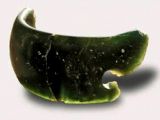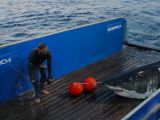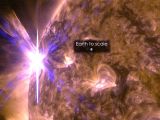This otherwise perfectly ordinary Sunday marks the demise of yet another week. As per usual, this means it's time to review the best and the most important science news of the past few days.
We have no intention to take too much of your time or keep you from enjoying what’s left of the weekend, so we’ll try to keep it short. These being said, here’s what’s been up in the world of science since our last encounter.
10. Bracelet found in Siberia said to be the world’s oldest
Some time ago, in 2008, a bracelet was found in a cave in Siberia. The bracelet is made of a mineral called chlorite. In daytime, it reflects sun rays and appears almost black. When kept close to flames in the darkness, however, it changes color to a deep green.
When the bracelet was discovered, scientists had no doubt that it dated back to ancient times. This week, the jewel’s exact age was revealed: 40,000 years. This makes it one of the oldest - if not the oldest - such piece of jewelry thus far discovered.
9. Pillars of Creation imaged in 3D for the first time ever
A recent investigation carried out with the help of the European Southern Observatory’s Very Large Telescope managed to produce a three-dimensional view of the Pillars of Creation. The view, included in the gallery below, is a world first.
The Pillars of Creation, described by astronomers as ginormous columns of gas and dust, are located in the Eagle Nebula about 7,000 light-years away. They were sculpted by stellar winds and intense radiation and will disappear in about 3 million years.
8. Great white shark Mary Lee spotted near New Jersey, US
In 2012, OCEARCH pulled a massive great white shark from the water and attached a tracker to its dorsal fin. Over the past few weeks, the shark, named Mary Lee, has been moving along the US eastern coast. On Friday, it was spotted near Atlantic City, New Jersey.
The reason this news grabbed headlines is because Mary Lee is quite a celebrity online. Mind you, this shark even has its own Twitter and Facebook account. In case anyone was wondering, Mary Lee measures 16 feet (4.8 meters) in length and weighs some 3,450 pounds (1,560 kilograms).
7. Record-breaking atmospheric concentrations of CO2 announced
A new report delivered by NOAA researchers says that, in this year’s March, global atmospheric concentrations of carbon dioxide surpassed 400 million parts per million. Such figures have been documented on several other occasions, but only in specific regions.
Scientists say that, since pre-industrial times until present day, atmospheric levels of carbon dioxide have upped by 120 million parts per million. This increase coincides with a 1.6-degree Fahrenheit (0.9-degree Celsius) rise in average temperatures around the world.
6. Centuries-old pirate treasure discovered in Madagascar
This week, a group of underwater archaeologists presented Madagascar’s president with a silver bar tipping the scales at roughly 50 kilograms (110 pounds). They say that they found the bar in the waters off the coast of the island of Sainte-Marie and that it is part of pirate treasure.
This treasure that the explorers say is buried underwater is believed to have belonged to Scottish pirate William Kid, a.k.a. Captain Kid, and to date back to around the 17th century. Hopefully, we’ll soon get to see more of it than just a silver bar.
5. Dr. Google accused of ineptitude diagnosing people
Turning to one search engine or another for help with self-diagnosis is a common practice these days. According to a new study, however, search engines are not as good physicians as people think them to be. Au contraire, they often lead folks to the wrong diagnosis.
Specialists warn that, since self-diagnosis tends to go hand in hand with self-treatment, this is a threat to public health as people could make themselves sick by taking medication for a condition they don’t really have but were led to believe that they do.
4. Biggest solar flare so far this year documented on the Sun
Towards the beginning of the week, on Tuesday, a massive burst of radiation was documented on the surface of the Sun. The event, known to astronomers as a solar flare, happened in an area dubbed Active Region 2339 and peaked at 6:11 p.m. EDT.
The Solar Dynamics Observatory closely observed the burst and imaged it in different wavelengths. Having analyzed these views, scientists classified the solar flare as an X2.7-class one, with X class flares being the absolute most powerful that can happen.
3. Onions used to engineer artificial muscles able to contract
A new research project saw scientists use cells obtained from good old onions to engineer artificial muscles capable of contracting and bending in different directions in response to applied voltage, just like muscles made from actual muscle cells do.
To make their artificial muscles, the researchers behind this investigation first arranged the onion cells in a neat layer and then coated them with gold. When this peculiar sandwich-like structure was zapped, it flexed upwards or downwards depending on the intensity of the voltage.
2. Russian cargo ship lost in space came crashing down on Earth
On April 28, a Soyuz rocket carrying a Russian cargo ship meant for the International Space Station launched from the Baikonur Cosmodrome in Kazakhstan. Once freed from the Soyuz rocket, the cargo ship started spinning out of control and was lost in space.
This past May 8, the space vehicle came tumbling down to Earth. According to the Russian Federal Space Agency, it entered our planet’s atmosphere over the Pacific Ocean. Most of it burned high up in the atmosphere, and whatever pieces remained landed in water.
1. The Eta Aquarids meteor shower peaked on Wednesday, May 6
Each year in spring, our planet finds itself traversing the trail of debris produced by Halley’s Comet and the Eta Aquarids meteor shower happens. This year, the shower peaked on Wednesday, May 6, when meteors were visible at a rate of 30 per hour.
This time around, it was folks in the southern hemisphere that had a front row seat to the event. Guys and gals in the northern hemisphere, on the other hand, only witnessed a few streaks of light. As for Halley’s Comet, we’ll have to wait until 2061 to catch a glimpse of it.
This concludes this week’s round-up of the coolest science news that came our way over the past few days. To keep up to date with what researchers are up to, be sure to check this page again a week from now.

 14 DAY TRIAL //
14 DAY TRIAL // 









